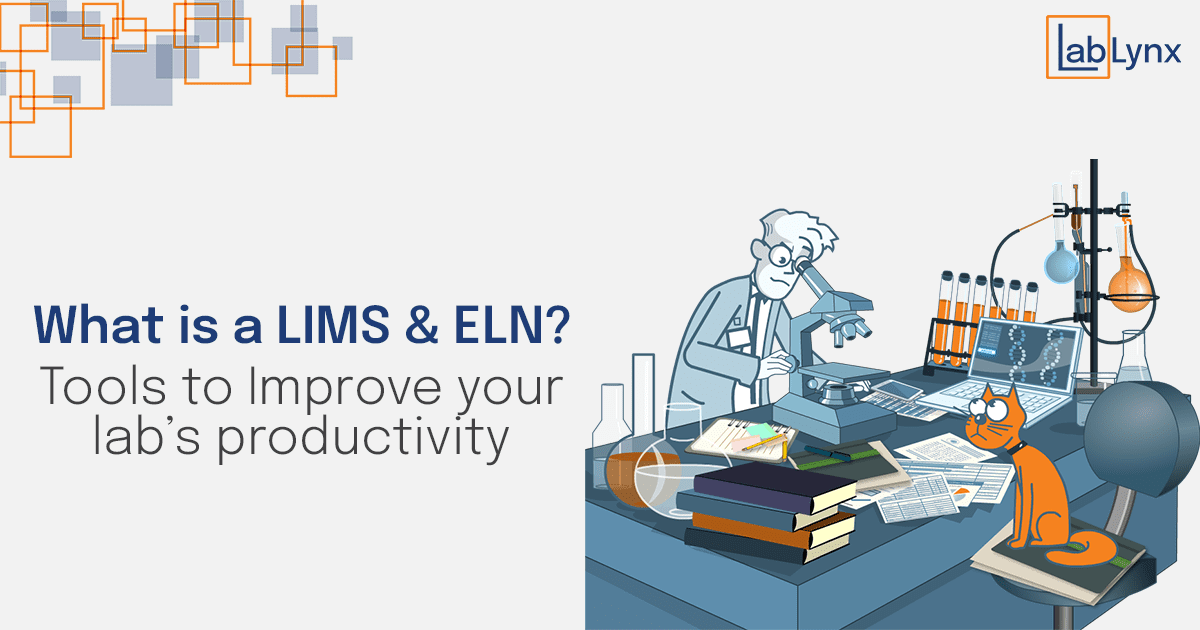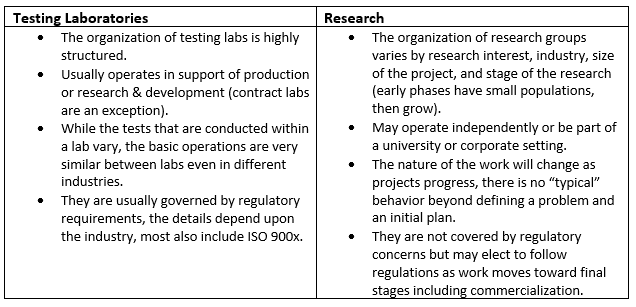What is a LIMS & ELN?

By: Joe Liscouski | March 25, 2022
 Saltwater and freshwater aquariums are micro-ecological systems that have to be carefully maintained to keep their inhabitants healthy and thriving. Among the conditions that have to be monitored are temperature, salinity, pH, total hardness, free chlorine, iron, copper, nitrite, ammonia and nitrate to name a few. Other measurements may be needed depending on the specialized needs of the tank’s inhabitants. Testing regularly is important, or your creature’s well-being may suffer. How do you keep track of these results? For a home aquarium, a logbook or even a spreadsheet may suffice. This is the way many startup labs begin, using paper records and spreadsheets to collect lab data and information.
Saltwater and freshwater aquariums are micro-ecological systems that have to be carefully maintained to keep their inhabitants healthy and thriving. Among the conditions that have to be monitored are temperature, salinity, pH, total hardness, free chlorine, iron, copper, nitrite, ammonia and nitrate to name a few. Other measurements may be needed depending on the specialized needs of the tank’s inhabitants. Testing regularly is important, or your creature’s well-being may suffer. How do you keep track of these results? For a home aquarium, a logbook or even a spreadsheet may suffice. This is the way many startup labs begin, using paper records and spreadsheets to collect lab data and information.
While paper/spreadsheets may work for a home system, what happens when you’re managing many tanks and specimens like those found in large regional aquariums (or samples in your lab)? It doesn’t take long for the workload to overwhelm paper notebooks and spreadsheets. Not only do you have to:
- keep control over the test data/information,
- you have to make it easy to work with,
- be able to respond to questions about testing status (is one tank showing signs of stress?),
- be able to repeat/confirm tests,
- add additional testing as required to meet special needs,
- keep track of work that is in progress as well as new samples submitted, and
- produce reports so that those working in the facility have an up-to-date picture of what is going on in the exhibits they are responsible for.
Laboratory Information Management Systems
The same issues exist in testing lab situations that include quality control, contract testing and routine/non-routine testing and investigations that support R&D programs. Using a software system known as a Laboratory Information Management System (LIMS) we can address those concerns. The purpose of a LIMS is to help you improve your control over your lab’s activities and manage the workflow consisting of:
- Samples coming into the lab, logging them in along with the location of the sample,
- Updating the testing schedules for work that needs to be performed,
- Keeping track of results as they are produced, checking to see if results are within expected ranges, and flagging those that fall outside,
- Tracking rush/high priority samples,
- Maintaining a log of work completed, left to be done, and flagging overdue testing,
- Having the sample’s results reviewed, approved, or flagged for further action,
- Reporting results back to the submitter, and
- providing management reports on the lab’s performance, including key performance indicators (KPI).
In addition, the results of the instrumental analysis could be fed directly into the LIMS, reducing clerical work. Finally, the system would help streamline workflow by providing a central repository for data and information, one that could be queried for status, worklists (noting priority and overdue samples) for each analyst/test. It replaces the laboratory paper chase with an easy-to-use controlled environment for finding out what work has to be done, organizing results and sending those results to the submitter. All of the data/information is in one place making it easy to manage and use.
What does that mean for our aquarists? Any data they need on an exhibit’s conditions are easily found, extracted, plotted and evaluated. If desired, an overview of the facilities condition can be had and deviations from normal identified before they become serious. If samples need to be resubmitted for further work, it’s a simple matter of logging in, making the request and waiting for the results.
Why is this important to you?
The laboratory paper/people chase is replaced with a well-managed system that is capable of growth as needed. It puts lab data/information – the product your lab was put in place to produce – in a controlled environment that can be backed up and prevents loss of access regardless of how long ago it was produced.
Large aquariums are also research facilities, doing work on everything from medical conditions of sick or injured animals to studying new species, behaviors, optimizing habitat conditions, inter-species interactions and the impact of climate change in the oceans and rivers. Research work has different demands on laboratory systems than the testing labs noted above.

In addition to carrying out the work, research groups are characterized by two other points: the need to publish their work, and the need to collaborate with other researchers. For example, our aquarist researcher studying a climate change problem in New England may need to exchange data with another working in California or New Zealand.
Until the advent of electronic systems, the most common tool used to support research work was the paper notebook. It was flexible, charts, graphs, tables, etc. could be pasted into it, but it suffered from all the ills of paper books including being lost. The biggest problem was its inability to participate effectively in producing publications and collaborations. Searching was manually done and is time-consuming. That need led to the development of the Electronic Laboratory Notebook (ELN).
Electronic Lab Notebooks & Laboratory Execution Systems
The ELN is essentially a diary of someone’s or a group’s work. Early implementation ranged from word processors and specialized software for recording experimental results, now referred to as Laboratory Execution Systems (LES) that found a ready home in regulated workplaces such as the pharmaceutical and biotech industries. They would record the results of each test in detail which would ease compliance with GxP regulations. Modern ELNs are more flexible and have a better application to research work.
If you had a paper notebook and wanted to keep records of your experiments, you might organize pages so that they’d contain:
- a description of the work and how you plan to address it,
- what experiments are going to be conducted,
- allocate space for tables of results, charts, and instrument printouts,
- comments on the day’s work with adjustment to planning as needed, and
- space for your signature and that of the person who reviewed your notes.
The details would vary from one researcher to another and might vary within a project as results suggested the need for additional work or a different direction. For an ELN to provide the same capability, it couldn’t be built around a particular structure but would have to have a variable structure, so it could be modeled after your needs. One of the differences between LIMS and ELN is often described as LIMS being “highly structured data” and ELNs as “unstructured”. That’s not quite accurate; ELNs don’t have a predictable structure (as does LIMS) but once a researcher defines the elements of an ELN project it is as “structured” as any other database.
What does that mean to you?
It means that the content of the ELN database can be searched via parameters that are meaningful to you, data and information can be extracted, plotted and analyzed according to your research interests. That can be done without going through pages of handwritten notes, so it’s much more efficient and makes better use of your time. It can also be worked with from anywhere you are (security issues permitting). No more “I’d like to look this up but my notebook is in the lab”. In addition, the database can be electronically backed up with no danger of lost work. It is also an effective aid in preparing publications.
Other features of ELNs
- ELNs can automatically acquire data from a LIMS system. Test results from your project’s samples can be electronically entered into the ELN database, reducing manual effort and the possibility of transcription errors.
- Each researcher can have their own project pages for their work. If a large project has several people working on it, they can conduct their work and share it with those who need to have access to it. Since it is done electronically (with access controls) you don’t have to find people to gain access to needed data/information. That sharing can extend to collaboration with people in your group or allied groups with controls that protect privacy concerns.
- The content of ELN projects can also contain videos, and the results of mathematical modeling work, moving it well beyond paper systems.
- Many ELNs can link to other database systems, both corporate and commercial. If our aquarium researcher found a molecule that was of interest, they could query a commercial database and get more information through the ELN. Need sophisticated graphics, or want to order supplies, that can be accommodated as well.
The ability to connect a LIMS and ELN deserves additional comments. Once that link is established, you should be able to submit samples to a testing lab for analysis and have the results entered directly into your ELN. The nature of the research work may require specific testing with results turn-around times that could not be supported by a central lab or contract facility. In that case, your lab may elect to install a LIMS of its own to support that work. The results from both the central testing lab and the LIMS in your lab could both be incorporated into the ELN.
Summary:
In this note, we’ve used a research aquarium to set the stage for the comparison between three informatics products: LIMS, LES and ELNs. That setting was taken as one that would be easy to understand and help illustrate the application of those software systems. Those informatics systems can be used in any industry or scientific setting. The key feature is the nature of the work and how it’s conducted. It is a matter of what fits your needs.
Laboratory Information Management Systems, are:
- Highly structured.
- Designed to assist testing laboratories (Quality Control, contract testing, and in-house testing in support of R&D) in the management of their workflows, administrative activities and keep track of samples (incoming, in-process, and completed), their status and results.
- Samples may be logged in manually, in a batch (to support large testing programs) and remotely by the submitter.
- LIMS also provides a mechanism for automatically incorporating instrument data into the database, evaluating results against expected norms and providing for results review, approval and reporting.
Laboratory Execution Systems
- Primarily intended to support GxP regulated environments by providing documented proof that work was performed by certified analysts, equipment, and reagents, according to a specific procedure, with data and results that can be forwarded to a LIMS or ELN.
- An LES can find a home anywhere that documented proof that laboratory procedures are followed correctly is needed.
Electronic Laboratory Notebooks
- Are designed to be used in any research application and are best understood as an electronic diary of work. ELNs can be useful in research testing labs to support method development and non-routine analysis.
- They are highly flexible providing the researchers with tools to construct a data/information collection/management system geared to how they want to work. Their design does not presuppose any behavioral model as do LIMS and LES.
- They provide mechanisms for data/information sharing and collaboration between researchers in the same group or different organizations with access controls to protect both data/information and privacy.
- Their ability to connect to corporate and commercial databases can provide a researcher with an entire research library at their fingertips. Videos, specialized graphics systems, scientific databases, statistical analysis and modeling systems, equipment catalogs, etc. can all be made available.
- They can be configured to automatically link to LIMS and LES so that test results can be incorporated into the researcher’s database reducing manual effort and the potential for transcription errors.
To learn more about LabLynx’s ELab LIMS and ELabNotes ELN, click here to schedule a call with our team, or email us at sales@lablynx.com.
















